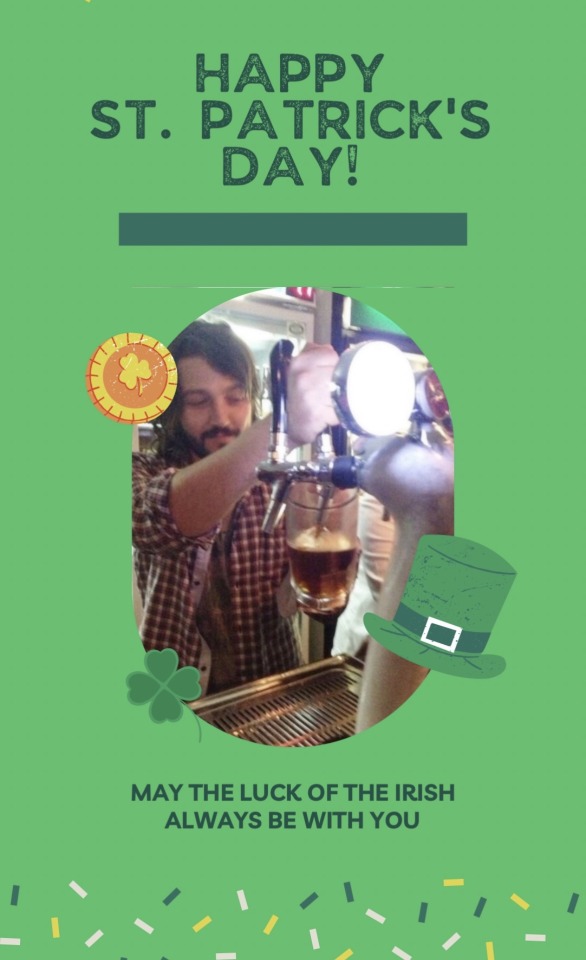#st. patrick’s day
Explore tagged Tumblr posts
Text
#holiday#holidays#new year’s eve#valentine’s day#st. patrick’s day#halloween#christmas#poll#tumblr polls
70 notes
·
View notes
Text









Happy St. Patrick’s Day
#joseph quinn#joseph quinn moodboard#☆ luna moodboard#green aesthetic#st. patrick’s day#joe quinn moodboard#joe quinn#joseph quinn imagine#green day
36 notes
·
View notes
Text
Catherine, Princess of Wales 👑 Meets with Guardsmen and their Families on St. Patrick’s Day, Wellington Barracks on 17 March 2025 in London, England
#kate middleton#princess of wales#princess catherine#royal#st. patrick’s day#duchess of cambridge#british royal family
15 notes
·
View notes
Text
My birthday is in 6 days I would love to keep the lights on as a gift to myself. I’m $70 short and anything helps.
Happy early St. Patrick’s Day
Cashapp: $ChenoahChantel
Venmo: @ChenoahChantel
PayPal: @ChenoahChantel
PayPal Link: https://www.paypal.me/ChenoahChantel
59 notes
·
View notes
Text

Happy St. Patrick’s Day 💚🎉 this is a photo I took during my Máméan pilgrimage hike last summer, one of the best days of my life and a very important moment in my conversion story.
#my priest said mass up here#and it changed my life#May 29th 2024#St. Patrick’s Day#St. Patrick#Christianity#Catholic#Catholicism#Ireland
9 notes
·
View notes
Text

On this date in 1837 three of my maternal ancestors left rural County Cork for what they hoped would be a better life in the United States.
This country repaid their faith many times over as it continues to do so for my sibling and me.
Happy St. Patrick’s Day.
16 notes
·
View notes
Text

#i made this too late in the day last year#so i queued it to post 365 days later like a normal person#midnight mass shitposting in the year of our lord 2025#midnight mass#st. patrick’s day#☘️
7 notes
·
View notes
Text
Color Monologue
Because color is one of my obsessions, I figured I’d share this. It’s nice to have names for the colors we don’t often have words to describe.
Below are some charts for examples, followed by a personal monologue.
List of Colors: 550 Color Names and Hex Codes









(If you can distinguish between these shades of black, let me know…. I can’t! Lol)


Finding My Favorite Color

Spoiler alert: It’s #E0EE00
Their “summary” color charts don’t include my favorite color, so I went into their more in-depth lists and found Bitter Lemon, which I think is about right. Actually, this “traditional” Chartreuse is likely closer:

My Favorite Color is an Experience
When people ask me what my favorite color is, I may come off as ridiculous when I respond “the color of new spring leaves when sunlight shines through them,” but it’s really the truth.
I care a lot about that exact sensation. It’s very captivating to me. I don’t even have to get on a plane to witness it. I can just go down the street or to a local park.
The experience of standing under a tree and gazing up through its branches is enchanting, and this array of color tones glows around me and inside of me. The below image kind of communicates this idea.

I particularly like the yellower green, right where the sun hits the leaves. Source
The term “chartreuse” is still inexact because the examples provided are usually not yellow enough.
This next pic is just for fun:

Source
Using a Color Picker to Find My Favorite Color
Here are some more examples of my favorite color.
Color Picker Source I’m aware these are multiple shades, but oh well. I’m searching.


Sometimes I feel like I get to my favorite color fastest if I go to yellow first, then darken it a little.

Funny how this color now looks worse as I place it against the dark background of Tumblr. In fact, it looks like boogers and I don’t like it as much at all.

The hex code “E0EE00” is really satisfying. Old Macdonald had a farm, E-0, E-E, 0-0…..
I think I’ll settle there for now.
Clothing With (Almost) My Favorite Color

Source

Source
It’s very, very difficult and rare to find clothing in my favorite color.
Is Chartreuse Green or Yellow?
(and who cares?)
Sometimes I wear a sweater from F21 that is pretty close to my favorite color, and people compliment me on my “yellow sweater,” at which I am always amused. To me, the sweater is green. So I have fun randomly asking people if they think the sweater is yellow or green. I just like to see which one they say. There are no wrong answers. I, too, remain uncertain as to which general category my favorite color inhabits. Relatedly, “Chartreuse” falls under “Green,” while “Chartreuse (traditional)” falls under “Yellow” on the first website I linked, List of Colors: 550 Color Names and Hex Codes. (Their version of “Chartreuse” I do not like at all. It is way too blue-green and not yellow at all.) Well, It’s a good thing that the determination of whether this shade is “yellow” or “green" is not particularly important one way or the other, because if people cared about this, I do think they’d never come to a consensus.
Clothing Website Color Pickers
I do, however, wish clothing websites would recognize “chartreuse” in a keyword search or have a more intelligent color picker when filtering results. It would not be too hard to code a tool that analyzes each clothing image and provides 10-20 color names depending on the hex codes it picks up. One could build in a “margin of error” where hex codes that are within a few degrees of variation are also included under those names. So the user could actually use a color picker (or a longer selection of specific colors, at least) to filter by color, and all matching or near-matching clothes would be included in the results.
Thanks for coming to my color monologue!

Source
#colors#color chart#color names#colorful#art#colorful art#color-meanings.com#color meanings#yellow#red#orange#black#white#blue#green#chartreuse#color monologue#hex codes#hex color codes#hexadecimal codes#hexadecimal#color picker#html color codes#html#hex#clothing#fashion#green clothes#st. patrick’s day#rare colors
8 notes
·
View notes
Text
youtube
Happy St. Patrick’s Day!
23 notes
·
View notes
Text

Slow Cooker Guinness Beef Stew
(March 17)
4 notes
·
View notes
Text

17 Days of Luck Day 17: Clover
Happy St. Patrick’s Day, everybody!
3 notes
·
View notes
Text
Happy St. Patrick’s Day!

2 notes
·
View notes
Text

12 notes
·
View notes
Text
☘️ Chicago’s St. Patrick’s Day Parade: A Beautiful, Bizarre Mess ☘️ Every year, Chicago celebrates Irish heritage by dumping 50 pounds of eco-friendly dye into the river, turning it so aggressively green that even Kermit the Frog would be concerned. This, of course, is the opening act to a day-long festival of shamrocks, questionable decision-making, and an alcohol-fueled sense of camaraderie that makes strangers in oversized Guinness hats momentary best friends. And yet, despite the public drinking, the sea of “Kiss Me, I’m Irish” shirts (worn by people whose last name is clearly Miller), and the occasional person who falls into the river, the city still insists this is a wholesome, family-friendly event. Sure. Because nothing says “bring the kids” like a guy dressed as a leprechaun loudly debating the merits of Old Style beer at 10 AM. So whether you’re here for the culture, the chaos, or just to witness Chicagoans turn into seasonal Irish philosophers, one thing is certain—this parade is a national treasure. 💚🍻 Sláinte, you magnificent lunatics. 🍻💚
#Chicago#comedy#Drinking Culture#Irish Culture#John Oliver Style#Local Events#River Dyeing#Satire#St. Paddy’s Parade#St. Patrick’s Day
2 notes
·
View notes

